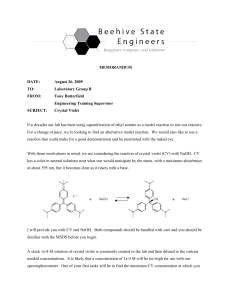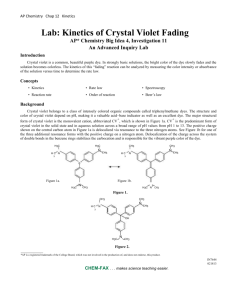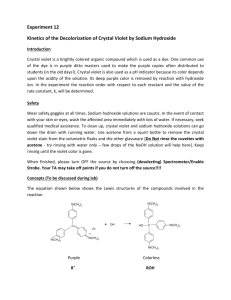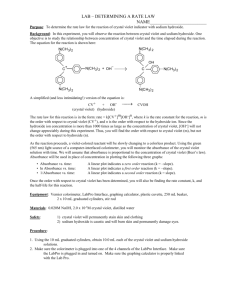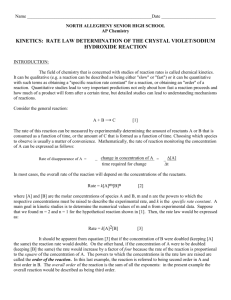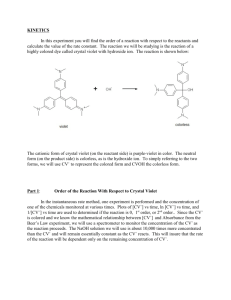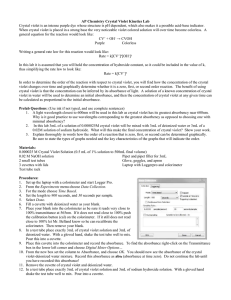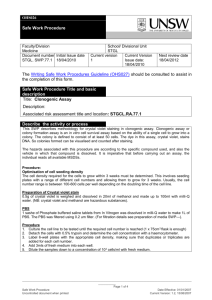Rate of Reaction of Crystal Violet with Sodium
advertisement
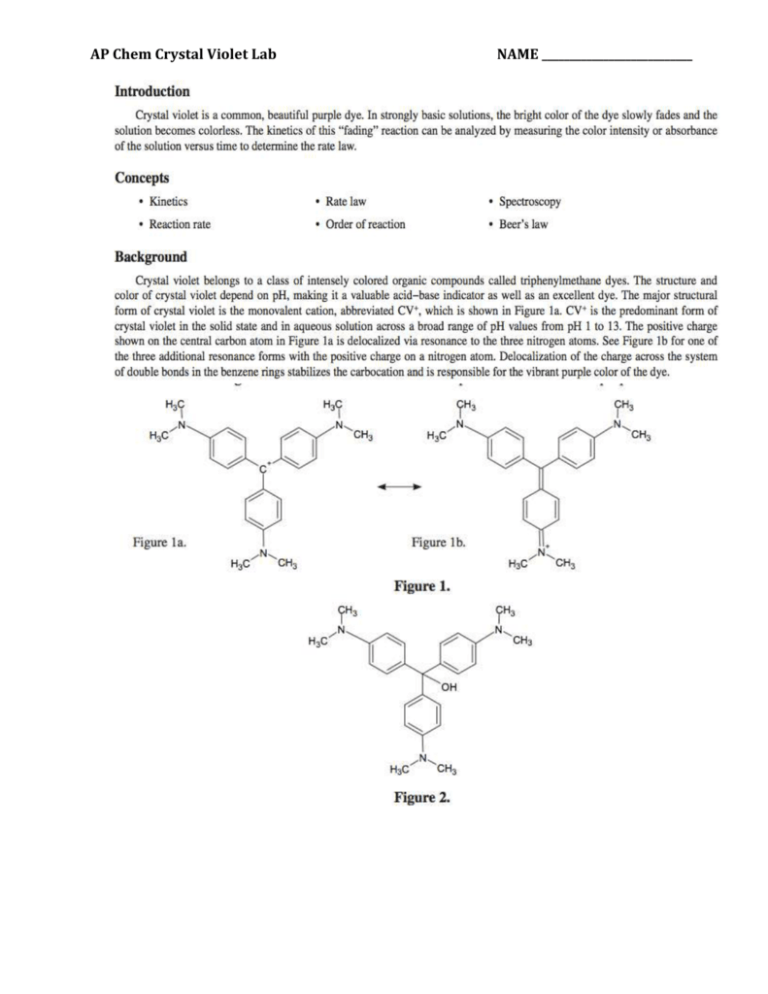
AP Chem Crystal Violet Lab NAME ___________________________ Purpose: The purpose of this advanced inquiry lab activity is to use spectroscopy and graphical analysis to determine the rate law for the color-fading reaction of crystal violet with sodium hydroxide. The lab begins with an introductory activity (laboratory technique) for constructing a calibration curve of absorbance versus concentration for the dye crystal violet. A series of known or standard solutions is prepared from a stock solution of crystal violet and the absorbance of each solution is measured at an optimum wavelength. A Beer’s law plot of absorbance as a function of concentration may be used to calculate the concentration of any “unknown” solution of the dye in a rate law experiment. The procedure provides a model for guided-inquiry design of experiments to determine the order of reaction with respect to both crystal violet and sodium hydroxide. Procedure: Part I Constructing a Calibration Curve for Crystal Violet 1. Turn on the spectrophotometer and allow it to warm up for 15–20 minutes before use. Adjust the wavelength setting to the optimum wavelength determined in the Pre-Lab section. 2. Read the entire procedure before beginning and construct an appropriate data table to record measurements. Note: As part of a cooperative laboratory activity, your instructor may assign different groups to prepare different solutions. Each group will need to transcribe and analyze data for all of the solutions and resulting measurements in order to complete the guidedinquiry activity. 3. Using a serological pipet for accuracy, prepare the series of standard dilutions of the crystal violet stock solution. Use the amounts calculated in the Pre-Lab assignment. Lab Hint: To avoid contaminating the stock solution, first use the pipet to add the required amount of distilled water to each test tube. Rinse the pipet three times with the stock solution, and then measure and add the required amount of stock solution to each test tube. Mix as needed. 4. Measure and record the absorbance (A) of the stock solution and each standard solution (dilution) at the selected wavelength. 5. Prepare a Beer’s law calibration curve of absorbance versus concentration for crystal violet using LoggerPro. SAVE this document. Procedure: Part A Rate of Reaction of Crystal Violet with Sodium Hydroxide 6. Assume that the reaction of CV+ with OH− ions (Equation 1) proceeds to completion, that is, the solution turns colorless. What percentage of OH− ions will remain at the end of reaction if the initial crystal violet to sodium hydroxide mole ratio is 1:1? What if the initial ratio is 1:1000? 7. Review the conditions for a pseudo-rate law in the Background section. Which mole ratio described above should be used to ensure that the reaction between CV+ and OH− ions can be treated using a pseudo-rate law to determine the reaction order n with respect to [CV+]? 8. Consult your textbook or other resources for mathematical treatment and graphical analysis of experimental data of con- centration versus time for disappearance of a reactant [A] in a reaction. Match each linear graph shown below with that expected if the reaction is (a) zero order, (b) first order, and (c) second order with respect to [A]. 9. Explain how the value of the pseudo-rate constant kcan be calculated from the appropriate linear graph shown above for a first-order reaction. 10. Write a detailed step-by-step procedure for a kinetics experiment between crystal violet and sodium hydroxide to deter- mine the order of reaction with respect to CV+. Include the materials, glassware and equipment that will be needed, safety precautions that must be followed, the concentrations of reactants, total volume of solution, order of mixing, timing, accuracy, etc. 11. Review additional variables that may affect the reproducibility or accuracy of the experiment and how these variables will be controlled. 12. Carry out the experiment and record results in an appropriate data table. Analyze the results: Use the calibration curve to determine the concentration of CV+ over the course of the rate trial. Calculate the values of ln [CV+] and 1/[CV+] and perform the graphical analysis described in Question 3 to determine the order of reaction n and the value of the pseudo-rate constant k. Procedure: Part B Order of Reaction with Respect to Sodium Hydroxide 13. The experiment can be extended to determine the order of reaction m with respect to [OH−] by varying the concentration of hydroxide ions [OH−]. Assume that the value of the pseudo-rate constant kwas measured for two different concentrations of [OH−]. The value of kwas found to be 0.13 at [OH−] = 0.2 M, and 0.061 when [OH−] = 0.1 M. Show how you can rearrange and combine the following two equations (see Equation 4) to solve for m. 0.13 = k= k[0.2]m and 0.061 = k= k[0.1]m 14. Propose or recommend the concentration of [CV+] that should be used in this part of the experiment when varying the hydroxide ion concentration. Explain. 15. Working cooperatively with other student groups, identify appropriate concentrations of sodium hydroxide for two additional rate trials of the color-fading reaction between crystal violet and hydroxide ions. If needed, carry out some rough trial-and-error experiments to make sure the new concentrations of [OH−] will give reactions that occur at convenient rates, that is, neither too fast nor too slow. 16. Review additional variables that may influence the results and write a detailed step-bystep procedure for Part B. Analyze the results: Combine the class data as needed. Graph the results as in Part A to determine the values of kat the new hydroxide ion concentrations. Use the mathematical treatment derived in the answer to Question 1 to calculate the reaction order m with respect to hydroxide ions [OH−].
